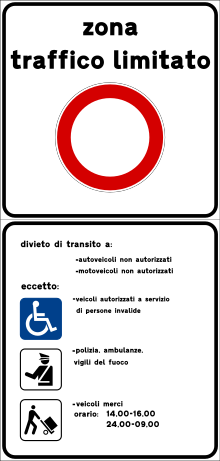
Back Zona a traffico limitato Czech Zone mit beschränktem Verkehr German Zone à trafic limité French Zona a traffico limitato Italian 交通規制区域 (イタリア) Japanese 교통제한구역 Korean Zone met beperkt verkeer Dutch 限行區 (意大利) Chinese

Limited traffic zone (LTZ) is type of restricted traffic area found in many historic European city centres where non-residents and unauthorized vehicles are prohibited from driving at certain times.[1] These areas are relatively abundant in Italy, where they are called zona a traffico limitato (ZTL), but they also exist in Spain, Portugal, France and Poland with different names. Around 350 Italian cities have LTZs, and 250 have low-emission zones (LEZs), usually enforced with camera surveillance.[2] They help protect historic city centres from excessive traffic, which would otherwise make the city less attractive. They can also be aimed at limiting pollution levels or at increasing administrative revenue by paying an urban toll.[3]
In most Italian LTZs (ZTLs), vehicles transporting people with disability are allowed when displaying the appropriate badge. As Article 47 of the Italian Traffic Code (Codice della Strada) defines bicycles as vehicles, cycling is only allowed if specified on the road sign. Unauthorized movement of vehicles in a ZTL is punishable by a fine under Article 7(14) in conjunction with the relevant city ordinance, and the fine is between 83 and 332 euros.[4]
In 2009 the city of Florence issued an average of 1,253 traffic tickets a day, for an annual revenue of 52 million euro. The fines tripled over the previous ten-year period. In the same year revenues from traffic fines in Milan were 81 million euro. About 53% of these fines come from LTZ violations.[5]
- ^ "Limited traffic zone in Italy". European Consumer Centre Germany. 15 July 2022. Retrieved 2 August 2022.
- ^ "Italy". Urban Access Regulations in Europe.
- ^ "Calendario Storico 2017" [Historical Calendar 2017] (PDF) (in Italian). Comune of Priolo Gargallo. 2017. Archived (PDF) from the original on 7 March 2022. Retrieved 2 August 2022.
Tra gli scopi di questo provvedimento si annoverano: ... aumentare le entrate amministrative anche con l'eventuale pagamento di un pedaggio urbano
[The purposes of this provision include: ... increasing administrative revenues also with the eventual payment of an urban toll] - ^ Nuovo codice della strada [New Traffic Code] (Decree 285, 7) (in Italian). Italian law. 30 April 1992. Archived from the original on 14 February 2022. Retrieved 8 August 2022.
- ^ "Too much of a bad thing". The Florentine. February 12, 2009. Retrieved February 20, 2021.
© MMXXIII Rich X Search. We shall prevail. All rights reserved. Rich X Search